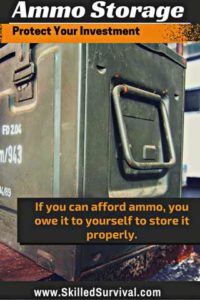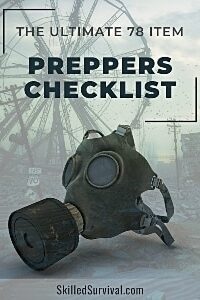
A Complete Guide On Storing Your Ammo The RIGHT Way
Because if you can afford to stockpile ammo, you owe it to yourself to store it properly.
You should treat your ammunition like precious metals.
Both require good storage practices to maintain them for the long haul.
If you don’t properly maintain your ammo (or neglect it), it’s shelf life will be cut short.
And this would be a travesty.
Because ammo is a critical supply in an emergency.
TOPICS IN THIS GUIDE… ↓(click to jump)
- Does Ammo Go Bad?
- Old Ammo Vs. New Ammo
- How To Store Ammo The Right Way
- Best Ammo Cans For Sale
- Humidity Control and Desiccants
- Your Long-Term Storage Plan
Want a free 78 item prepper checklist?
Click here to instantly download this Complete Checklist PDF. No purchase necessary.
Does Ammo Go Bad?
Yes, ammo DOES have an expiration date.
But unlike food, which has a shelf life measured in days or weeks, the life of ammo is measured in years and decades.
It all depends on HOW you store it.
If stored right, it can outlive YOU.
Heck, it may even outlive your kids and your grandkids.
If in good condition, modern ammo can last centuries.
But if you store your ammo improperly, degradation starts on day one.
Slow at first, but you may find your ammo useless over a few years.
And even if it still fires, I wont’ be accurate.
↓ Does Ammo Go Bad / Accuracy?
Want a free 78 item prepper checklist?
Click here to instantly download this Complete Checklist PDF. No purchase necessary.
Old Ammo Vs. New Ammo
Modern materials, design improvements, and automated manufacturing have improved today’s shelf life.
And that’s great news for those who stockpile.
When discussing “older ammo,” I primarily reference ammo manufactured after the 1930s.
Back when smokeless powder was introduced.
↓ Black Powder Vs. Smokeless Powder
Older bullets had a much shorter shelf life unless meticulously stored.
Today, the risk vs. reward of shooting older ammo may not be worth it.
And the equation keeps getting worse as each year passes.
↓ Will These 90-Year-Old .22 Rounds Still Function?
The bottom line is:
Your ammo stockpile is an investment.
You want to protect this investment as long as humanly possible.
So let’s learn how to do just that:
How To Store Ammo The Right Way
Proper storage for ammo is not complicated.
You only need to follow some simple principles and take action.
Yes, that’s it.
Here’s the first storage principle:
Store your ammunition in a cool, dry, dark location.
Let’s break that down.
If you keep your ammo in a…
- Cool
- Dry
- Dark
…place, you win.
Follow this, and you’ll extend your ammunition stockpile from decades to centuries.
Once we analyzing this principle, we discover there’s a bit more to it.
So let’s dive deep into each of these storage principles:
↓ How To Store Ammunition
Keeping Your Ammo Cool
You want to keep your ammunition cool.
Not cold but cool.
Avoid warm or hot storage locations.
Constant warm temps or consistently cool temps are not the main concern.
It’s the temperature swings that are the real problem.
The integrity of ammo is compromised if it’s subjected to extreme temperature cycles.
It’s hard on ammo to go from 100 degrees to 0 degrees and back to 100 degrees, year after year.
Why is this bad?
These temperature swings invite humidity.
And as we’ll discuss shortly, humid environments are a serious threat to ammunition.
That’s why garages, attics, unheated cabins, and the trunk of your car are poor locations.
These storage locations are susceptible to extreme heat and cold swings.
- In winter, overnight temps can reach sub-zero degrees in garages, attics, etc.
- And in the summer, north of 100 F.
Ammo stored in such locations will seem fine for the first few years…
But if left in these locations over several decades, the temperature swings will begin taking a toll.
So, where should your ammo be stored?
Basements are popular.
Why? Because basements are located below ground level.
Ground temperatures change less than air temperatures.
So while air temps will change from 0 degrees to 100 degrees seasonally, ground temps 10 feet below the surface tend to stay in a range of 20 degrees.
So, for example:
If soil temps 10 feet underground average 50 degrees, it may rise to 60 degrees in the summer and drop to 40 degrees in winter.
This is significantly less variation than air temps.
And at 30 feet below the surface, temperature swings become negligible.
At this depth, ground temps stay constant regardless of the air temps.
So we can take advantage of the earth and support the “constant cool” principle.
That’s why basements are popular ammo storage locations but they can have downsides too.
Which we’ll cover next…
Keeping Ammo Dry
Moisture is even more dangerous to your ammunition than temperature swings.
Moisture is corrosive to metal.
And ammo is made of metal (brass casings, primers, and bullets).
Hence, moisture exposure will eventually rust your ammo.
It will begin with small amounts of surface rust.
You can sand this off, and it will still fire…
But even this may affect its accuracy.
And if this rust is allowed to fester, it will eventually (over several decades) render your ammunition useless.
So we need to control moisture.
But guess which part of our homes tends to have the highest humidity levels?
You’ve probably guessed it…
Basements.
Rain soaks into the ground.
Ground contacts your home’s foundation.
This ground moisture is dangerous to foundations if allowed to accumulate.
That’s why ensuring your gutters and downspouts are working properly is important to avoid foundation problems (i.e., cracking, settling heaving, etc.)
Many homes have sump pumps to help manage basement moisture issues.
When massive flooding occurs, which area gets wet first?
Your basement.
So from a moisture standpoint, basements present a problem.
However, there are solutions to help manage these risks.
First, if you’re storing ammo in a basement, don’t set it on the floor.
Keep it in cabinets or racks.
The higher, the better.
That way, if your basement floods, your stockpile will remain above the water level.
Another way to manage the increased humidity in the basement air is to get a good dehumidifier.
This dehumidifier unit will continuously pull moisture out of a damp basement.
You also should remove the ammo from the orgnial boxes.
Why? Because there are trace amounts of moisture in that carboard.
And if you put your ammo in ammo cans (and you should) the air tight containers will pull that moisture out.
Instead, get them away from cardboard and into an ammo can.
Keeping Your Ammo “In the Dark”
UV light is also a destructive force.
Over long periods of exposure, the sun’s harmful UV rays will break down nearly everything.
You’ve seen this process with vehicles.
Leaving a vehicle in the sun for years deteriorates its exterior.
Compare THAT vehicle to one stored in a garage.
Over a long time, UV rays will take a similar toll.
The good news is:
Most indoor storage areas work just fine.
A closet, pantry, and basement are all protected from UV rays.
Plus, the inside of your ammo cans will be dark as well.
So if you store your cans in a windowless location, UV rays become a non-issue.
Organization Matters…A Lot
Good storage takes organization and discipline.
Remember, you’re stockpiling for decades.
So it’s important to stay organized and maintain control of the inventory.
It’s not ‘set and forget.’
You must maintain a process.
↓ How I Organize My Ammo Cans MTM Ammo Cans
<iframe loading="lazy" title="How I Organized My Ammo Cans





